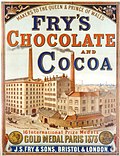Chocolate bar
Chocolate bar refers to a confectionery product that is typically made from cocoa solids, sugar, and milk, although there are many variations that include a range of nuts, fruits, and other ingredients to enhance flavor and texture. The process of making a chocolate bar involves harvesting cacao beans, fermenting, drying, roasting, and grinding them into a paste, which is then mixed with other ingredients and molded into its final shape.
History[edit]
The history of the chocolate bar dates back to the ancient Mesoamerican civilizations, including the Maya and Aztecs, who first cultivated cacao and prepared it as a beverage. However, the modern chocolate bar's origins can be traced to the early 19th century, following the invention of the cocoa press by Coenraad Johannes van Houten, which made it possible to extract cocoa butter from the cacao beans, leaving a dry cake that could be pulverized into a fine powder known as cocoa. This process significantly reduced the bitterness of chocolate and allowed for the production of solid chocolate by adding back extracted cocoa butter.
Types of Chocolate Bars[edit]
Chocolate bars can be broadly categorized into three types based on the proportion of cocoa used in their production:
- Milk Chocolate: Contains milk powder or condensed milk along with cocoa butter and sugar. It is known for its creamy texture and sweet flavor.
- Dark Chocolate: Made with higher proportions of cocoa and less sugar than milk chocolate, offering a more intense chocolate flavor.
- White Chocolate: Contains cocoa butter, sugar, and milk but no cocoa solids, giving it a sweet, creamy flavor and a pale color.
Popular Brands and Varieties[edit]
Several chocolate manufacturers have become famous for their unique chocolate bar offerings. Some of the most well-known brands include:
- Cadbury, known for its Dairy Milk bar
- Nestlé, famous for the KitKat and Crunch bars
- Hershey's, known for its classic milk chocolate bar
- Lindt, recognized for its premium dark chocolate bars
Cultural Significance[edit]
Chocolate bars have become an integral part of many cultures around the world, often associated with holidays and celebrations. They are popular gifts, especially on occasions like Valentine's Day and Easter, and are also used in a variety of desserts and baking recipes.
Health Aspects[edit]
The health benefits of consuming chocolate bars vary depending on the type of chocolate and the quantity consumed. Dark chocolate, in particular, is rich in antioxidants and has been linked to various health benefits, including improved heart health and reduced inflammation. However, chocolate bars also contain high levels of sugar and fat, which can lead to health issues if consumed in excess.
Environmental and Ethical Considerations[edit]
The production of chocolate bars has raised several environmental and ethical concerns, particularly regarding the sourcing of cacao. Issues such as deforestation, child labor, and unfair trade practices in the cacao industry have prompted calls for more sustainable and ethical production methods. Many chocolate manufacturers are now committed to using Fair Trade and organic cacao to address these concerns.
-
Chocolate_bar
-
Chocolate_bar
-
Chocolate_bar
-
Chocolate_bar
-
Chocolate_bar
-
Chocolate_bar
-
Chocolate_bar
-
Chocolate_bar
-
Chocolate_bar
-
Chocolate_bar
-
Chocolate_bar
-
Chocolate_bar
Ad. Transform your life with W8MD's Budget GLP-1 injections from $75


W8MD offers a medical weight loss program to lose weight in Philadelphia. Our physician-supervised medical weight loss provides:
- Weight loss injections in NYC (generic and brand names):
- Zepbound / Mounjaro, Wegovy / Ozempic, Saxenda
- Most insurances accepted or discounted self-pay rates. We will obtain insurance prior authorizations if needed.
- Generic GLP1 weight loss injections from $75 for the starting dose.
- Also offer prescription weight loss medications including Phentermine, Qsymia, Diethylpropion, Contrave etc.
NYC weight loss doctor appointmentsNYC weight loss doctor appointments
Start your NYC weight loss journey today at our NYC medical weight loss and Philadelphia medical weight loss clinics.
- Call 718-946-5500 to lose weight in NYC or for medical weight loss in Philadelphia 215-676-2334.
- Tags:NYC medical weight loss, Philadelphia lose weight Zepbound NYC, Budget GLP1 weight loss injections, Wegovy Philadelphia, Wegovy NYC, Philadelphia medical weight loss, Brookly weight loss and Wegovy NYC
|
WikiMD's Wellness Encyclopedia |
| Let Food Be Thy Medicine Medicine Thy Food - Hippocrates |
Medical Disclaimer: WikiMD is not a substitute for professional medical advice. The information on WikiMD is provided as an information resource only, may be incorrect, outdated or misleading, and is not to be used or relied on for any diagnostic or treatment purposes. Please consult your health care provider before making any healthcare decisions or for guidance about a specific medical condition. WikiMD expressly disclaims responsibility, and shall have no liability, for any damages, loss, injury, or liability whatsoever suffered as a result of your reliance on the information contained in this site. By visiting this site you agree to the foregoing terms and conditions, which may from time to time be changed or supplemented by WikiMD. If you do not agree to the foregoing terms and conditions, you should not enter or use this site. See full disclaimer.
Credits:Most images are courtesy of Wikimedia commons, and templates, categories Wikipedia, licensed under CC BY SA or similar.
Translate this page: - East Asian
中文,
日本,
한국어,
South Asian
हिन्दी,
தமிழ்,
తెలుగు,
Urdu,
ಕನ್ನಡ,
Southeast Asian
Indonesian,
Vietnamese,
Thai,
မြန်မာဘာသာ,
বাংলা
European
español,
Deutsch,
français,
Greek,
português do Brasil,
polski,
română,
русский,
Nederlands,
norsk,
svenska,
suomi,
Italian
Middle Eastern & African
عربى,
Turkish,
Persian,
Hebrew,
Afrikaans,
isiZulu,
Kiswahili,
Other
Bulgarian,
Hungarian,
Czech,
Swedish,
മലയാളം,
मराठी,
ਪੰਜਾਬੀ,
ગુજરાતી,
Portuguese,
Ukrainian











